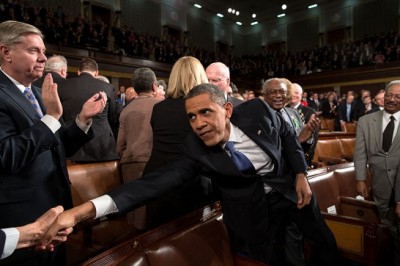Questions about how much President Barack Obama’s ambitious early childhood partnership plan will cost and how quality will be maintained emerged immediately on Thursday, soon after Obama delivered long-awaited details in Decatur, Ga.

President Barack Obama reaches to shake hands with a Member of Congress as he arrives to deliver the State of the Union address at the U.S. Capitol in Washington, D.C., Feb. 12, 2013. (Official White House Photo by Pete Souza)
“Study after study shows that the earlier a child begins learning, the better he or she does down the road,’’ Obama told an enthusiastic crowd after a visit to an early childhood learning center. “Let’s make it a national priority to give every child access to a high-quality early education. Let’s give our kids that chance.”
The plan calls for a guarantee of preschool for all four-year-olds who are at or below 200 percent of the poverty line. It would expand funding for childcare programs for infants and toddlers as well. And teachers would have to meet high quality standards, while earning salaries in line with K-12 teachers, according to reports.
The speech produced joy – and skepticism.
“President Obama is trying, against great odds, to do something for 4-year-olds,” noted New York Times columnist Gail Collins, who pointed out that other presidents have tried and failed, while “working parents of every economic level scramble madly to find quality programs for their preschoolers, while the waiting lines for poor families looking for subsidized programs stretch on into infinity.”
Yet advocates and educators who have been pushing hard for the president to tout a larger federal role in early education found plenty of reasons to cheer the initiative, which first came up during the president’s State of the Union speech on Tuesday.
“It represents a milestone achievement that begins to place the United States in a position comparable to the nations of whom we routinely compete with economically,’’ said Professor Sharon Lynn Kagan, co-director of the National Center for Children and Families at Teachers College, Columbia University. “We have not had services for three- and four-year-olds voluntarily available in the past. So I regard this as a real policy advance.”
The plan also calls for expanding home-visiting initiatives that would provide nurses, social workers and others to meet in the homes of at-risk families and connect them with assistance.
“Voluntary home-visiting matches parents with trained professionals to provide information and support during pregnancy and throughout their child’s first few years—a critical developmental period,” noted Libby Doggett, director of the Pew Charitable Trusts home-visiting campaign. “Quality, voluntary home-visiting leads to fewer children in social welfare, mental health, and juvenile corrections systems, with considerable cost savings for states.”
But how will it all work? Questions remain about the cost, which has not yet been specified. Estimates are as high as $10 billion to $15 billion a year or more. “The money, of course, is the sticking point,” noted a New York magazine story.
House Republicans, the story points out, “are not the sort of people who, when presented with evidence of a really promising public investment program, nod their heads and say, ‘Okay then!’”
That’s a point duly noted by Rep. John Kline (R-Minn.), chairman of the House Education and the Workforce Committee. “We can all agree on the importance of ensuring children have the foundation they need to succeed in school and in life,’’ Kline told Education Week. “However, before we spend more taxpayer dollars on new programs, we must first review what is and is not working in existing initiatives, such as Head Start.”
Jerlean Daniel, executive director of the National Association for the Education of Young Children, is among the advocates who noted that bipartisan support will be needed, as well as a focus on quality.
“When program providers and schools do not have the financial and other resources to hire skilled teachers, to purchase appropriate curricula and equipment, and meet other quality standards, we create conditions of achievement inequity for children and undermine a valuable workforce,” Daniel said in statement.
Many challenges lie ahead. States and the federal government, points out Lisa Guernsey of the Early Ed Watch blog, are going to “need to offer preschool programs that are good enough to make a real, lasting difference for young children.”



